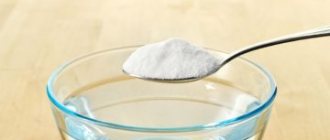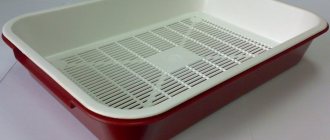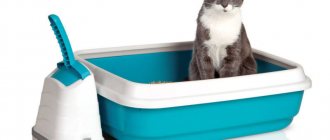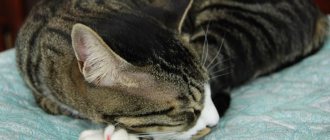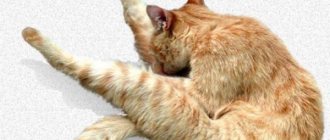Design of a cat litter box with grate
This tray consists of two elements: a tray and a grid that is placed on top of it. A grate is needed in the cat's litter box so that the cat does not get dirty in his feces. Like the vast majority of cat litter boxes, mesh litter boxes are made from plastic materials. This is because other materials, such as metal, react with the animal's feces and oxidize. This is dangerous due to harmful fumes that the pet and its owner will have to breathe.
Pros and cons of using
This tray, like any other thing, has its advantages and disadvantages. Main advantages:
- This toilet model is inexpensive, and in addition, the owner will be able to save on filler.
- Since the filler is completely hidden in the tray, the cat will not be able to reach it and taste it.
- Compared to conventional plastic toilets, this tray option is more hygienic. After all, thanks to the grate, the pet does not come into contact with dirty litter and does not spread it throughout the house on its paws.
- Variety of colors. A person can choose just such a cat litter box with a grate that would fit into the interior of the apartment.
Main disadvantages:
- Daily washing. The grate of the litter box will have to be washed every time your pet uses the restroom. Otherwise, it will get dirty with the products of its vital activity, and an unpleasant smell will hang in the apartment.
- A cat litter box with a grid is suitable only for those owners who spend their time mainly in the house. If you do not wash the mesh in time, the animal may refuse to relieve itself again in a dirty tray, and this is fraught with “surprises” in the most unexpected places.
- Smell. If you do not use fillers, then such an open tray will invariably emit not the most pleasant odors.
The last disadvantage can be easily avoided. You just need to add wood filler to the tray; it absorbs moisture and retains odors.
In what cases are sewer clogs likely?
In addition to the composition of the product used by animal owners for their toilet, the initial condition of the sewer pipes also plays an important role in the question of whether wood filler can be flushed down the toilet or some other kind.
For example, if the drains in an old house have not been changed for several decades, then the likelihood of a blockage increases significantly, even if you only flush wood products down the toilet and do this in small quantities.
There is also a high probability of clogging of sewer pipes when a large amount of waste filler is flushed at a time. The toilet is quite complex; there are specific bends in the drain. The design is made in this way in order to prevent the release of unpleasant odors and the rise of wastewater from the pipes. If you flush a full tray of waste filler into the toilet at once, it will inevitably “get tightly stuck” in one of the bends of the drain or behind it, in the pipe.
How to use a cat litter box with bars
The mesh toilet is very easy to use. It can be used with or without filler. To use a litter box with a cat grid, follow these steps:
- the container is installed in a secluded place, but so that the animal has round-the-clock access to it (for example, under the bathroom);
- filler or simple sawdust is poured into the tray tray so that it covers the bottom (if liquid gets on them, the granules swell greatly, so you should not overdo it with the quantity);
- A mesh is placed on top of the tray and the toilet is ready for use.
In order for the animal to regularly go to the same place when needed, you need to use the cat litter box correctly and take care of choosing the appropriate litter.
How to disinfect cat litter?
If the tray is new and cleaned regularly, then it practically does not emit unpleasant odors. But over time, microscratches form in the plastic bottom, into which particles of urine, feces and dust become clogged. The question arises: how to wash the tray without smelling?
Modern means
Household and pet stores sell special products for cleaning cat litter boxes and eliminating unpleasant odors. Why is it better to use them for disinfection purposes?
- They do not cause allergies in pets and are safe in case of licking.
- Eliminate stubborn urinary stone stains on the bottom and walls.
- They have a neutral or pleasant smell for cats, which means that animals will not refuse to go to the tray after cleaning.
- Does not leave scratches.
- Eliminates odors of urine and feces.
The only drawback of modern products is the high price (500-800 rubles) compared to ordinary soap or baking soda.
Good brands include Hartz and Joypet sprays, Super Benek powder, Mr. plaque and urinary stone cleaner. Fresh. The last two products are inexpensive.
Common Home Remedies
How to disinfect a cat's litter box if your budget is limited or you're just too lazy to go to the store? You can use regular detergents:
- laundry or baby soap (grate the shavings and dissolve in water);
- liquid soap;
- a mild detergent, such as delicates powder;
- dishwashing liquid;
- baking soda - 2 tablespoons per 200 ml of water.
It is important to choose a product without a strong odor, and at the end, thoroughly rinse the cat’s litter box in clean water, preferably several times. Cats especially do not like the aromas of citrus and coniferous trees. If the smell remains on the walls, the pet will pass by its toilet and relieve itself somewhere in a corner or on the carpet.
We recommend: How to properly and effectively wash a floor depending on the type of coating?
What absolutely cannot be used for disinfection?
- products containing chlorine - there is a high probability of poisoning when licked and inhaled;
- vinegar - most likely, due to the pungent smell, the cat will prefer another toilet place to the tray;
- powders like "Pemolux" - leave scratches on the plastic surface of the bottom.
Don't forget to clean the area around the tray. After relieving itself, the pet often digs into the litter: lumps fly to the floor, and dust rises into the air. Dirt near the toilet may be one of the reasons why a cat has a desire to shit in the apartment.
How to choose a filler?
If there is no opportunity for regular washing, then to avoid odors it is worth using cat litter. In the pet store they are presented in a wide range of different materials:
- Silica gel absorbs liquid better than other granules and absorbs odors. It is made from dry silicate gel, so it is toxic. It is not recommended to use it in apartments where small kittens live. They can taste it, and in addition, the silica gel granules begin to fizz when they get wet. This may frighten your pet.
- Wood filler is also effective in controlling odors. Absorbing liquid, its granules increase in size by 2-3 times. Therefore, you need to pour it in small quantities, which allows you to save a lot.
- Mixed clay and sawdust filler. Despite the fact that it copes well with the task, it also has disadvantages. It is also not suitable for kittens, as they may swallow it. And when they react with liquid, the granules become wet and can stick to the pet’s fur.
- Regular sawdust. Sawdust blocks odor quite well, but is significantly inferior in this regard to wood filler.
- Sand. River sand only absorbs moisture, but does not eliminate the odor at all, so you have to change the filler often.
Of the options listed, the most versatile would be wood filler. It can be used for kittens and adults, for healthy animals and animals prone to allergies. But if several individuals live in the house, then the best way to deal with the smell is silica gel.
Cats rarely do anything out of spite, so if the owner finds a puddle in the wrong place, he should not scold the cat. You just need to change the filler and monitor your pet’s reaction.
How to change the filler correctly?
The frequency of changing the filler depends on its type. For example, wood pellets that have been exposed to urine will scatter at the bottom of the tray. They are separated with a spatula from the surviving granules and thrown away. If there are no whole ones left, then remove all sawdust from the tray and wash it well under running water.
This type of litter can be changed once a week, provided that only one pet uses the toilet.
You can use cat litter, such as silica gel, for two weeks and only then change it completely. But it is better to remove already used lumps immediately. And the contents of the tray need to be stirred periodically for quick drying.
The mixed filler is also changed once a week. To do this, you need to use a special spatula with holes through which the used filler will be sifted from the clean one. After this procedure, fresh granules are added to the container.
Sand is the weakest among its competitors; it should be changed completely, preferably every day.
In addition, wet cleaning will be required around the tray, as grains of sand may spill outside of it. Each owner can decide for himself how much filler to add by observing the animal.
Required amount of filler per cat:
- wood filler - 1 layer;
- silica gel - 2 cm in height;
- mixed - 3 cm;
- sand - 1 cm.
All types of fillers have different granule sizes. This is convenient because you can buy small stones for kittens, in which they will rummage with interest, and this will help them quickly get used to the toilet.
How to train a cat?
Before you accustom your cat to use the toilet on a grate, you need to teach him to visit an open tray with litter. The younger the pet is, the easier it is to train it . When a cat goes to the toilet in the wrong place, put its solid waste in a pot, and moisten its liquid waste with newspaper and also put it in the container. Spray the area where the cat is not allowed to go to the toilet with a special repellent, you can find it at the pet store. Over time, the pet will understand what is required of it.
As soon as the cat has learned to go to the toilet in a certain place, you can put a grate on the tray and sprinkle some granules on top. Gradually reduce the amount of litter placed on the grate. When it is completely gone, the animal will already be accustomed to a specific place and over time will become completely accustomed to this method of visiting the toilet.
The subtleties of choosing a toilet for cats are presented in the following video.
